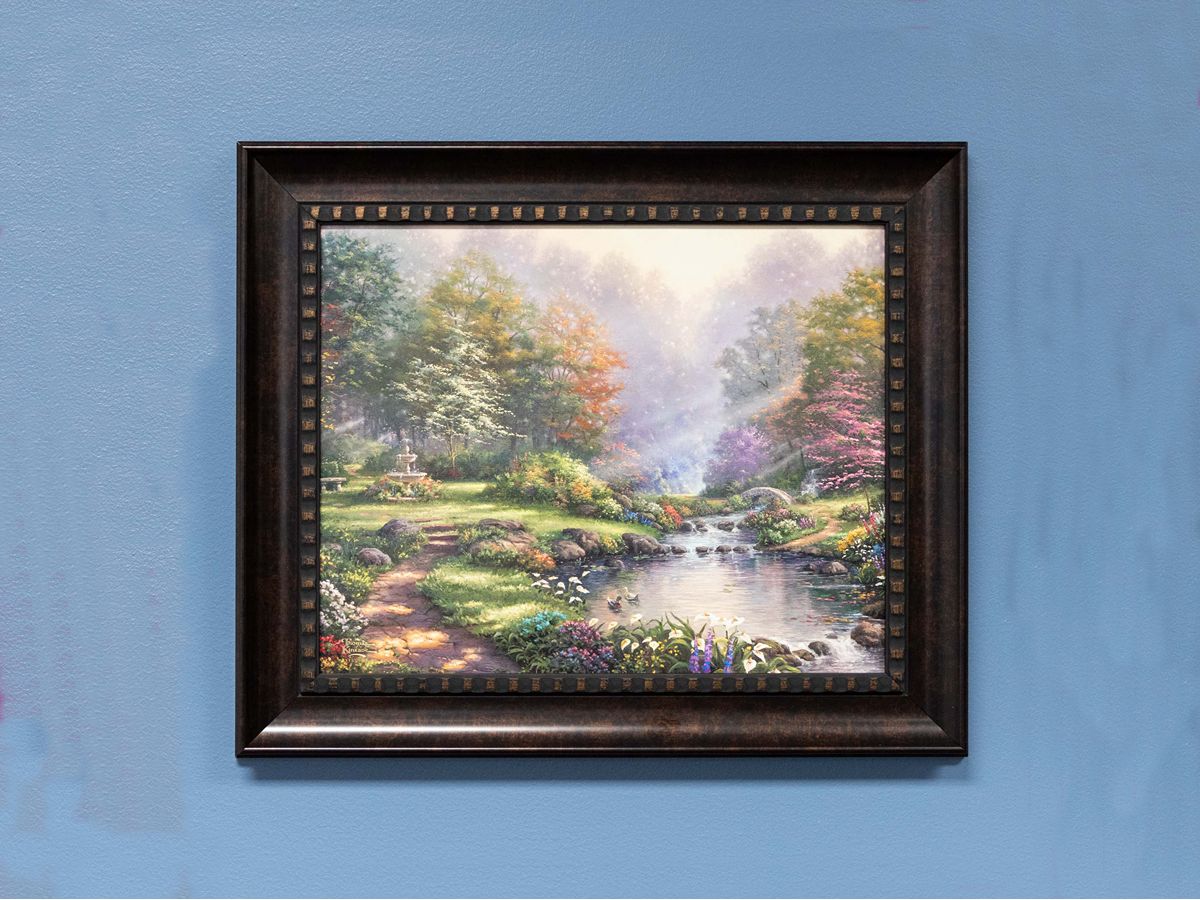Want to hang your favorite paintings without making holes in your walls? You’re not alone.
Many people worry about damaging their walls or dealing with messy repairs later. What if you could display your artwork quickly, safely, and without nails? In this post, you’ll discover simple, effective ways to hang paintings that protect your walls and keep your space looking great.
Keep reading, and you’ll learn easy tricks that anyone can do—no tools or damage required.
Choose The Right Hanging Method
Hanging paintings without nails keeps your walls safe. There are many ways to hang art without damage.
Pick the right method based on your wall type and painting weight. This guide helps you choose.
Adhesive Hooks And Strips
Adhesive hooks and strips stick to the wall and hold light to medium paintings. They do not leave holes when removed.
- Clean the wall before applying
- Press the hook firmly for 30 seconds
- Wait an hour before hanging the painting
- Check weight limits on the package
Velcro And Command Strips
Velcro and Command strips work well on smooth surfaces. They allow easy removal and repositioning.
| Type | Max Weight | Surface |
| Velcro Strips | 5 lbs (2.3 kg) | Painted walls, wood |
| Command Strips | 7.5 lbs (3.4 kg) | Tile, glass, drywall |
Tension Rods And Wire
Tension rods and wire offer support without wall damage. They work well between two walls or inside window frames.
Use sturdy wire to hang heavier paintings. Adjust tension rods to fit the space tightly.
Magnetic And Suction Solutions
Magnetic and suction hooks suit smooth surfaces like glass or tiles. They are easy to move and leave no marks.
Use suction hooks only on clean, non-porous surfaces. Magnets need metal backing on the painting or wall.
- Clean surface before attaching
- Check suction strength regularly
- Test magnet pull before hanging

Credit: www.amazon.co.uk
Prepare Your Wall And Artwork
Hanging paintings without nails needs good preparation. You must get your wall and art ready first.
Proper steps help your paintings stay safe and look great on the wall.
Clean And Dry The Wall Surface
Start by wiping the wall where the painting will hang. Use a clean cloth with mild soap and water.
Make sure the wall is dry before you attach any hooks or strips. Dampness can weaken the hold.
Check Weight And Size Of Paintings
Know the weight and size of your painting. This helps you pick the right hanging method.
| Painting Size | Weight Limit | Recommended Hanging Method |
|---|---|---|
| Small (up to 12 x 12 inches) | Up to 2 pounds | Adhesive hooks or strips |
| Medium (12 x 12 to 24 x 36 inches) | 2 to 8 pounds | Heavy-duty adhesive strips or hooks |
| Large (over 24 x 36 inches) | Over 8 pounds | Consider alternatives to nails carefully |
Protect Frames And Corners
Protect your painting’s frame and corners before hanging. This prevents damage during placement.
- Use soft cloth or bubble wrap on corners
- Wrap the frame gently with painter’s tape
- Handle the painting by its sides, not the frame
Step-by-step Hanging Techniques
Hanging paintings without nails keeps your walls clean. There are several simple methods to choose from. Each way uses tools that do not damage your wall.
Below are easy techniques you can try. Follow the steps carefully for best results. Pick the method that fits your wall type and painting size.
Using Adhesive Hooks
Adhesive hooks stick to the wall and hold lightweight paintings. Clean the wall area before attaching the hook. Press the hook firmly and wait for it to set. Hang your painting on the hook carefully.
- Clean the wall with rubbing alcohol and let dry.
- Peel the backing off the adhesive hook.
- Press the hook on the wall for 30 seconds.
- Wait one hour before hanging the painting.
- Hang the painting on the hook securely.
Applying Double-sided Tape
Double-sided tape works well for small frames. It sticks the painting directly to the wall. Make sure the tape can hold the painting’s weight. Apply tape strips on the back edges of the frame.
| Painting Weight | Number of Tape Strips |
|---|---|
| Up to 1 pound | 2 strips |
| 1 to 3 pounds | 4 strips |
| 3 to 5 pounds | 6 strips |
Press the painting against the wall firmly for 30 seconds. Check that it stays in place. Avoid hanging heavy paintings with this method.
Mounting With Velcro Strips
Velcro strips offer a strong hold and easy removal. Attach one side of the strip to the painting frame. Stick the matching side on the wall. Press the painting onto the wall strips firmly.
- Clean the wall surface well.
- Attach Velcro strips to the frame corners.
- Stick the matching Velcro strips on the wall.
- Press the painting onto the wall strips.
- Ensure the painting is secure before releasing.
Arranging With Tension Rods
Tension rods fit inside window frames or narrow spaces. Hang paintings by tying strings to the rods. This method avoids any wall contact. Adjust the rod length to fit your space.
- Measure the space for the tension rod.
- Place the rod securely between two walls.
- Tie a string or wire to the rod ends.
- Attach the painting to the string.
- Adjust the height as needed for display.
Tips For Securing Different Wall Types
Hanging paintings without nails protects your walls from damage. Different walls need different hanging methods. Use the right tools for each wall type to keep paintings secure.
This guide covers drywall, plaster, brick, concrete, wood, paneling, glass, and tiles. Find tips for each wall type below.
Drywall And Plaster
Drywall and plaster are common in homes but can be fragile. Avoid nails to stop holes or cracks. Use adhesive hooks or strips made for these walls.
- Clean the wall surface before applying hooks
- Choose hooks with strong adhesive backing
- Follow the weight limits on the packaging
- Press firmly and wait before hanging the painting
Brick And Concrete
Brick and concrete walls need strong support. Nails may not work well without drilling. Use heavy-duty adhesive strips or mounting putty for light paintings.
| Method | Best For | Notes |
| Heavy-duty adhesive strips | Light to medium frames | Clean surface, hold up to 5 lbs |
| Mounting putty | Very light frames or posters | Easy to remove, not for heavy items |
Wood And Paneling
Wood and paneling are sturdy but can dent from nails. Use removable adhesive strips or picture hanging hooks with minimal damage.
- Test adhesive on a small area first
- Use hooks with rubber pads to protect wood
- Choose strips that match the weight of your painting
Glass And Tiles
Glass and tiles are smooth and fragile. Nails will break them. Use suction cup hooks or special adhesive hooks for glass surfaces.
- Clean surface with rubbing alcohol before hanging
- Check suction cups for strong suction and no air bubbles
- Avoid heavy frames that suction cups cannot hold
Avoiding Common Mistakes
Hanging paintings without nails is a smart choice to protect your walls. Many people make mistakes that cause damage or make the painting fall.
Knowing what to avoid helps you hang your artwork safely and neatly. Here are common mistakes to watch out for.
Overloading Adhesive Products
Using adhesive strips or hooks that can’t hold your painting’s weight is a big problem. Too much weight causes the adhesive to fail.
Always check the weight limit on the package. Don’t try to hold heavy frames with light products.
- Use adhesive products rated for your painting’s weight
- Do not hang large or heavy paintings on light adhesive strips
- Consider multiple adhesive strips for better support
Ignoring Surface Conditions
Sticky products need clean, dry, and smooth surfaces to work well. Paintings may fall if you attach them to rough or dirty walls.
Make sure to clean the wall area before applying any adhesive. Avoid walls with wallpaper or textured paint for better results.
- Wipe the wall with a clean cloth
- Remove dust, grease, or moisture
- Choose smooth and flat wall spots
Skipping Weight Tests
Not testing the weight before hanging can cause the painting to fall unexpectedly. Testing helps ensure the adhesive holds well.
Try a small test by pressing the adhesive on the wall with some weight first. Adjust if it feels loose or weak.
- Apply adhesive and press firmly on the wall
- Wait a few minutes and gently pull to test hold
- Use more or stronger adhesive if needed

Credit: www.thomaskinkade.com
Removing Paintings Without Damage
Hanging paintings without nails is a smart choice. This method keeps walls safe from holes and scratches.
It’s important to know how to remove these paintings carefully. This ensures the wall remains pristine.
Safe Detachment Techniques
Use adhesive hooks for easy removal. These hooks are designed to be gentle on walls.
Stretch the adhesive strip slowly from the bottom. This helps prevent any damage to the wall surface.
- Hold the hook firmly
- Pull the tab straight down, not towards you
- Release the hook from the wall
Cleaning Residues
After removal, some adhesive might remain. Cleaning residues is essential for a clean wall.
Use a soft cloth and warm soapy water to wipe the area. Avoid harsh chemicals that could harm paint.
- Moisten the cloth with soapy water
- Gently rub the residue
- Dry the area with a clean towel
Wall Repair Tips
If the wall shows minor marks, simple repairs can help. These tips will restore the wall’s appearance.
For small scuffs, use a matching paint color. Apply with a small brush for even coverage.
| Issue | Solution |
| Small scuffs | Touch up with matching paint |
| Minor dents | Fill with lightweight spackle |
| Paint chips | Sand lightly and repaint |

Credit: www.amazon.ca
Frequently Asked Questions
What Are The Best Alternatives To Nails For Hanging Paintings?
Strong adhesive strips, hooks, and mounting tapes are great alternatives. They avoid wall damage and support various frame weights effectively.
Can I Hang Heavy Paintings Without Nails?
Yes, use heavy-duty adhesive hooks or wall-safe mounting brackets. Ensure the product supports your painting’s weight to avoid damage or falls.
How To Prevent Wall Damage When Hanging Paintings?
Use damage-free hanging products like removable hooks or adhesive strips. Always follow weight limits and carefully remove them to protect your walls.
Are Adhesive Hooks Reliable For Long-term Painting Display?
High-quality adhesive hooks can hold paintings securely for months. Regularly check their grip and avoid exposure to moisture for best results.
Conclusion
Hanging paintings without nails keeps walls safe and neat. You can use hooks, strips, or adhesive tapes. Each method holds pictures firmly and avoids damage. Choose the best way for your wall type. Simple tools make decorating quick and easy.
Enjoy a fresh look without extra holes. Your walls stay clean, and art stays up. Try these ideas to brighten your space today.

